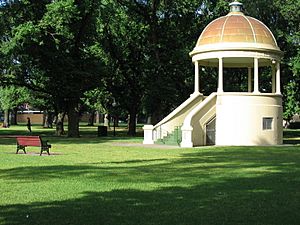Edinburgh Gardens, Melbourne facts for kids
Edinburgh Gardens is a big park located in North Fitzroy, a suburb of Melbourne, Australia. It's surrounded by Brunswick Street and St Georges Road on one side, Alfred Crescent curving around the north and east, and Freeman Street to the south. Queen Victoria gave the land for this park in March 1862. It was designed by Clement Hodgkinson, who also planned many other parks and gardens in Melbourne. At about 24 hectares (60 acres), it's a very large park for being in the inner city.
Contents
History of Edinburgh Gardens
Edinburgh Gardens has a long and interesting past, with many changes over the years.
How the Park Began
The area that became Edinburgh Gardens was first set aside as a public reserve in 1862. Soon after, the Collingwood Commercial Cricket Club started using part of the land. This began a tradition of organized sports in the Gardens that continues today. Around 1872, the reserve got its name, "Edinburgh Gardens." This name honored Prince Alfred, who was the Duke of Edinburgh.
For a while, the park wasn't fully developed, and animals still grazed on the land until the early 1880s. The Fitzroy Council became the official managers of the Gardens in 1878. In 1882, the Gardens were permanently protected. A formal design for the park, including digging trenches and tree planting, started in 1883. This design was created by Joseph Martin Reed, a surveyor for the Victorian Lands Department.
Changes Over Time
In 1888, the Gardens were divided when a piece of land was taken out of the middle. This was for building the Fitzroy spur line of the Inner Circle Railway. Even with the railway, the Gardens continued to be developed throughout the 1900s. More sports areas, decorative features, and memorial structures were added, along with new plants.
Today, Edinburgh Gardens still has most of its original path system. It also has many old elm trees and other special trees planted in the 20th century. A good number of important buildings and structures from the 1800s and early 1900s are still standing within the Gardens.
What Makes the Park Unique
The Edinburgh Gardens area is special because of its unusual "escargot" or snail-like shape. This unique shape came about to help connect different street layouts and create a grand crescent design. The idea was to have a large crescent with central gardens, playing fields, and railway facilities.
One strange feature of the park is a bare stone pedestal in the center. This pedestal was meant to hold a large statue of Queen Victoria. However, the statue only stayed there for three years before it mysteriously disappeared over a century ago. It was never replaced, and the empty pedestal remains as a curious reminder of the past.
The Old Railway Line
A branch of the former Inner Circle Railway once cut through the middle of Edinburgh Gardens. This Fitzroy spur line started near Park Street, crossed Mark Street and Alfred Crescent, and ended at the old Fitzroy Station. This station was located behind Brunswick Street Oval.
The passenger train service on this line was not very popular and closed just a few years after it was built. The area was then used as a freight yard until the 1980s. Today, you can still see some parts of the old train tracks in the park. The old level crossings were kept even after the tracks were removed. The path where the old line used to be is now a shared path for walking and cycling. It connects to the Linear Park Reserve and leads to the nearby Capital City Trail.
Factories that were once connected to the railway line have been torn down. The land they stood on was either given back to Edinburgh Gardens or sold. A wooden pedestrian bridge in the south-west of the gardens was removed around 2003.
W.T. Peterson Community Oval
At the south-western corner of the Gardens is an Australian rules football oval. It's officially called the W.T. Peterson Community Oval, named after a long-serving member of the Fitzroy City Council. However, many generations of Fitzroy Football Club fans know it better as the Brunswick Street Oval.
The ground can hold about 15,000 spectators. It was the home ground for the Fitzroy Football Club in the VFA and later the VFL competitions from 1883 until 1966. The last game played there was in August 1966, when Fitzroy played St Kilda and lost. Today, the Fitzroy Football Club still uses the ground for its VAFA games, and the Fitzroy Junior Football Club plays there too. It's considered the spiritual home of the Fitzroy club.
The playing field is still surrounded by its original features. These include the visiting members' gate structure at the corner of Freeman and Brunswick Streets, and a late 19th-century grandstand, gates, and ticket box on the opposite side of the oval. The main grandstand is listed on the Victorian Heritage Register because of its historical importance.
The biggest crowd ever at Brunswick Street Oval was on May 6, 1935. About 36,000 fans watched Fitzroy draw with Collingwood. Both teams scored 14 goals and 9 behinds, ending the game tied at 93 points each.
In Popular Culture
The Rotunda, which is located to the west of the Gardens, is a central feature in the song "Under The Rotunda" by the Melbourne indie-rock band The Lucksmiths.



